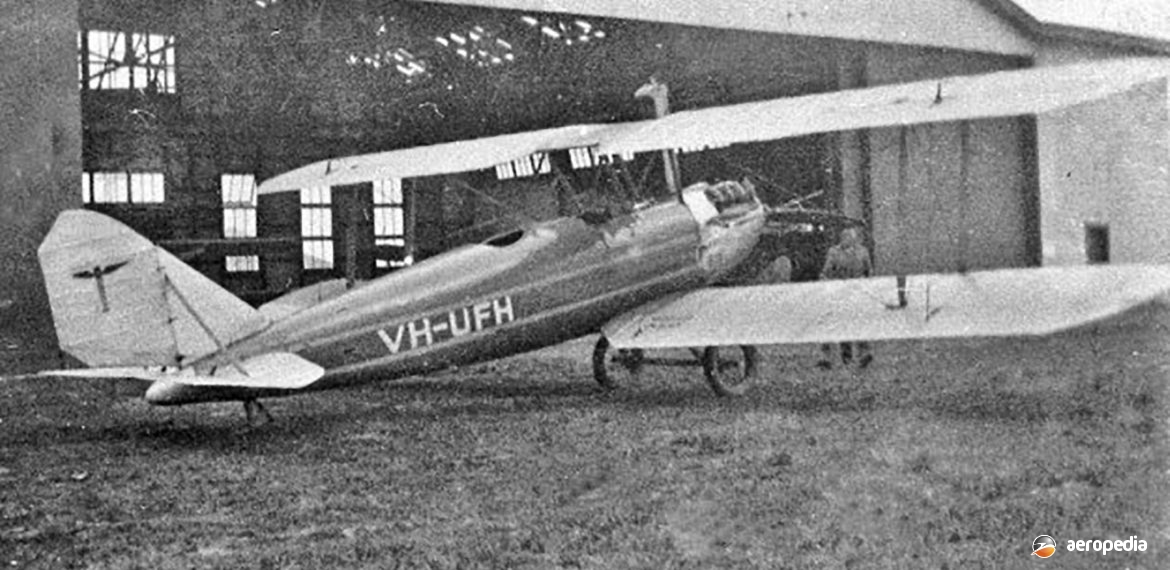Photograph:
Ireland Comet VH-UFH (c/n 0.38) at Mascot, NSW, circa 1930 (John Hopton collection)
Country of origin:
United States of America
Description:
Touring and training biplane
Power Plant:
One 67 kw (90 hp) Curtiss OX-5 eight-cylinder VEE liquid-cooled engine
Specifications:
- Wingspan: 10.97 m (36 ft)
- Length: 7.89 m (25 ft 10 in)
- Height: 3.1 m (10 ft 2 in)
- Wing area: 31.2 m² (336 sq ft)
- Max speed: 154 km/h (96 mph)
- Landing speed: 64 km/h (40 mph)
- Climb to 305 m (1,000 ft): 1 min 57 secs
- Climb to 1,524 m (5,000 ft): 16 mins
- Service ceiling: 2,286 m (7,500 ft)
- Endurance at cruising speed: 6.5 hours
- Range: 837 km (520 miles)
- Empty weight: 619 kg (1,365 lb)
- Useful load: 379 kg (835 lb)
- Loaded weight: 998 kg (2,200 lb
History:
In 1925 Mr G S Ireland of Garden City, New York, a former salesman for Curtiss Aeroplane & Motor Company Inc, entered the field of light aircraft production. He conceived the idea of making use of spare Curtiss Oriole fuselages and tails, and fitting them with new high-lift wings, the Oriole being well known for its extreme safety and durability. These wings were braced by a single strut bay rather than the double arrangement used on the Oriole. A more modern deeper rib section and increased area improved performance over that of the Curtiss aircraft. A new design undercarriage was also fitted. In order to achieve production, a facility was set up on Curtiss Field and the services were obtained of Curtiss engineering staff for the necessary design work.
First aircraft released was the Comet which was advertised as ”taking off with two passengers and a pilot with 45 gallons (170 litres / 37.5 Imp gals) of gas in a flat calm after a run of only 9 secs, and climbs 700 ft (231 m) the first minute. The guaranteed high speed is 90 mph (145 km/h) but the ship has averaged 97 mph (154 km/h) out and back over a measured course”. It was said the wings were designed to a load factor of nine as a minimum. It was normally supplied with the Curtiss OX-5 engine of 67 kw (90 hp), the Curtiss C-6 engine of 112 kw (150 hp) or the Curtiss K-6 engine of 119 kw (160 hp). A Hispano Suiza A or E could also be installed. With the C-6 engine fitted, maximum speed was 185 km/h (115 mph). The baggage compartment had a capacity of 10.2 kg (22.5 lb). No records have been available as to the number of Comets built but it is believed 40 were completed.
Two examples of the Comet came to Australia, where they appeared in records of the Civil Aviation Authority as the Curtiss Ireland Comet. These aircraft were G-AUFG (c/n unknown) first registered on 22 December 1926 and issued with Certificate of Registration No 149 to S L Tyler of Sydney, NSW. Ownership was transferred in 1927 to F T O’Dea, also of Sydney. The registration was cancelled in 1928, the aircraft spinning out of control from 610 m (2,000 ft) at St Peters, NSW, being destroyed.
The second Comet, G-AUFH (c/n 0.38), was registered on 1 March 1927 to C E McIntosh of Sydney and Certificate of Registration 155 was issued. Ownership was transferred to F T O’Dea in 1927, the aircraft being involved in an accident on 2 August that year. Ownership was transferred to Mr L L Nall in 1928 and the aircraft subsequently had a number of owners. In 1929, when registrations became VH for Australia, it became VH-UFH. In 1930 ownership was transferred to J Stanborough and W Buckingham of Sydney; and in 1932 to J Stanborough of Kogarah, NSW. Also in 1932 the registration lapsed.
It appears in 1966 this latter aircraft (VH-UFH) was discovered in a shed in Maitland, NSW and records indicated “fuselage was removed by persons unknown but reported to be living in the Lake Macquarie area. The wings will be collected soon. The shed has been flooded by every flood to hit Maitland in the last 30 years, so the fuselage must be in pretty bad shape. The wings are stacked in the rafters of the shed.” Further notes indicated “an old-time barnstormer and speedway champion Bob (Cowboy) Mills has donated his old Curtiss Ireland Comet biplane to a museum in Sydney” and “since the late thirties its water cooled V-8 engine has been used as a boat power-plant on Lake Macquarie”. The ultimate fate of the aircraft and its engine is not known.

